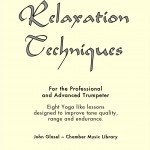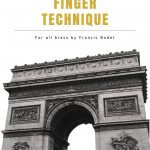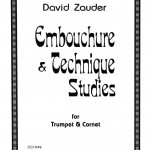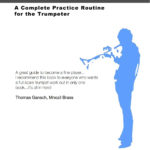Relaxation Techniques
Relaxation Techniques by John Glasel consists of a series of Yoga-like exercises designed for advanced and professional trumpeters who feel the need to improve tone quality, range, and endurance. These exercises serve to increase strength and eliminate tensions, thus developing greater efficiency in the use of the lips and breathing muscles. As your playing set-up becomes more relaxed, a more natural style of playing will emerge. Your sound will become more open, endurance will increase, and you will be able to add at least a third to your usable high register. Many Trumpet methods are collections of exercises or studies, sometimes arranged in a progression from easier to more difficult, but with little or no explanations of how to practice them. Relaxation Techniques is different: since how you practice is more important than what you practice, this book contains detailed instructions on how to practice each exercise, with particular attention to tempo, dynamics, articulation, breath control, mental attitude, and the amount of rest to be taken between exercises. Since this method of practicing is quite different from most other methods and totally unlike any known style ,of performing, all instructions should be carefully followed. Many of the instructions tend to make the easiest-looking exercises quite difficult. Do not take short-cuts to make them easier to play or better-soundIng. The success of this method depends on your constant attention to every detail of the instructions. Relaxation Techniques should be practiced daily. Practice time should be between 45 and 75 minutes per day. For best results, do not practice more than this amount and discontinue your regular practice routine. By limiting your practice you will break down tensions (bad habits) faster. Don't be afraid that this practice restriction will cause a loss of endurance-as limited as these exercises seem, they will keep you in condition. However, if you feel the need for some additional practice, you may spend five or ten minutes on such practice immediately before the last exercise of each lesson. Relaxation Techniques is organized as a series of lessons. Each lesson should be practiced daily for at least two weeks, except for Lesson I, for which one week is sufficient. Do not be in a hurry to go from one lesson to the next-unlike other methods, there is little value in progressing from the front to the back of the book. Indeed, many of the exercises are repeated fronl one lesson to the next. Every exercise in each lesson should be done well and fairly easily before going on to the next lesson, no matter how long it takes to achieve this. It is suggested that you use a loose-leaf format in practicing these exercises. Simply remove the binding staples, cut along the center fold, and punch holes to conform with your binder. Then you will be able to arrange each lesson's exercises consecutively and eliminate excessive page-turning during your practice sessions. (The decision to publish Relaxation Techniques in several volumes was due to the page limitation of wire-binding-other types of binding are harder to take apart.) Relaxation Techniques is derived from the teachings of the late Maurice Grupp, to whose memory these volumes are dedicated.
Pottag Complete Collection for Horn
Max Pottag’s output for French Horn consists of method books, technical exercises, etudes, duets, daily studies and more. Without a doubt, Pottag’s collection deserves a spot in the libraries of every aspiring and established hornist. This bundle will prove especially useful for teachers. The ability to bring students through progressive exercises, etudes, and duets gives students a linear trajectory of learning. The bundle, Pottag’s complete 10-book output for French Horn, is being offered for 50% off the standard price for only a short period of time. After looking through the samples to the left and reading the write-ups below, click above for an immediate PDF download of the entire set of books. Books Included:
- Pottag, Melodious Progressive & Technical Studies 1 & 2
- Pottag, French Horn Passages 1-3
- Pottag, 60 French horn Duets
- Pottag, Trio Album for French Horn
- Pottag, Daily Exercises for Horns
- Pottag, Preparatory Melodies to Solo Work
- Pottag, Quartet Album for Horns
Call & Response Beginner Trumpet (With Audio)
A "Call and Response", follow-the-leader, audio recording and text which enables the beginning trumpeter to determine whether or not he is playing the correct tone. The instructor continually reminds the neophyte, regarding essential matters, as they play together. "The next best thing to having a "live" competent teacher at your side!". Developed especially for the public school trumpet student who does not have access to a private tutor. It is equally effective with adult beginners as a "home-teaching" tutor. From the preface: To The Teacher One of the great problems confronting the beginning trumpeter, when he leaves his teacher and goes home to practice, is that of knowing whether or not he is playing the correct tone, according to the written note. With the supplied recordings, insecurity and bewilderment are eliminated. The Call & Response Beginner Trumpet method is a programmed, graduated tutor which enables the child to read and play instantly. Fingering, note names, breathing, tonguing, and other fundamental techniques are stressed when appropriate. Crutches, such as fingerings and written note names, are gradually deleted so that the student should not become dependent upon them. Daily use of the Call & Response Beginner Trumpet Method will:
A. Develop an appropriate concept of sound. B. Place a teacher at the student's side during the practice sessions, to offer reminders, admonish, and encourage. C. Develop an organized practice routine. D. Help to keep the student from being distracted. E. Simultaneously develop counting, reading, and rhythm skills. F. Greatly increase the probability of daily practice. G. Enable the parents to become more involved with the development of the child. H. Eliminate much of the student's frustration, guess-work, and insecurity, by providing immediate feedback regarding her efforts. I. Ensure an adequate amount of REST - a factor all-to-often ignored in elementary school band music!
To the left you can find some samples, below you can hear one of the audio files, and above you can grab an immediate digital download of the audio and the book together. Hear Clyde Hunt's Introduction [audio mp3="https://qpress.ca/wp-content/uploads/2020/11/01-Introduction-to-the-Trumpet.mp3"][/audio]Complete School for the Trumpet
Hermann Pietzsch's School for the Trumpet/Cornet (originally titled "Theoretisch-praktische Schule für Trompete") has been out of print for nearly 120 years and we are very proud to bring it back to life as a digital edition on qPress. You may know Pietzsch already from his wonderful etude book (22 Virtuoso Studies) and you would be right to assume that his trumpet method is an even more valuable addition to the trumpet repertoire. This book has been translated into French, English, and German, and is an exceptional step by step guide to all areas of playing, much like the Arban method. Things ramp up quickly and musical and stylish etudes following soon after the basics. Here is a break down of what is in each volume. Volume 1: Introductory reading, instrument mouthpiece embouchure, rhythm, scales, intervals, slurs, chromatics, dynamics, arpeggios, daily exercises, duets. Volume 2: Melodious exercises in all keys, trills, multiple tonguing, daily studies, duets, technical studies in velocity, transposing, high trumpet excerpts. This is a once in a lifetime find and available at only one trumpet music store on the planet. Grab some samples on the left then get your immediate digital download above. Enjoy everyone!
Complete Aaron Harris Trombone Collection
Aaron Harris' wonderful trombone catalogue has been in print for decades, non stop since their original release, for very good reason. A player can work through his collection from Scales, to daily exercises, then onto his advanced study books, all while working their way through his two part trombone method, creating an engaging and thorough course of trombone instruction. For the first time ever, qPress is bundling up all of his trombone books in one place to help you get the whole set at a fraction of retail price. Below we have bundled together 6 Aaron Harris trombone downloads at a 40% discount. This deal won't last long, so check out writeups at the links below, samples to the left, and grab an immediate PDF download above
- Harris, Trombone Method Book 1
- Harris, Trombone Method Book 2
- Harris, Scales & Etudes for Trombone
- Harris 44 Etudes
- Harris, Advanced Daily Studies Bass Clef
- Harris, Advanced Artistic Etudes Etudes Bass Clef
The Scale Book Bundle for Trumpet
No practice routine is complete without scale-study. Despite feeling “old-fashioned”, scales are still among the very best ways to improve your facility around the horn, finger technique, comfort in different key signatures, range, and flexibility. The good news is that the authors included in this bundle have been hard at work making sure that your scale study isn’t boring or stale. This bundle is perfect for jazz players and legit players alike, and is sure to take your playing to the next level. Click through the samples to the left, read through the write-ups provided below, and then click above for immediate PDF downloads of the entire bundle. Books included in this bundle:
- Ponzo, Scale Pattern Dexterity Exercises for Trumpet
- Hawkes & Son’s, Unison Scale Book for Trumpet
- Ponzo, Scale Patterns and Arpeggio Primer for Trumpet
- Colin, Complete Encyclopedia of Scales
- Stuart, Jazz Scales
- Veldkamp, Your Daily Minor Scales (& More)
- Veldkamp, Your Daily Major Scales (& More)
- Gornston, Fun With Scales
Finger Technique
Francis Bodet's Finger Technique is one of the most unique books on finger dexterity ever written for brass. It is intended for all valved brass instruments and is translated into Engligh, French, and German. What makes this book so unique? It is a part of his three book series on the most important aspects of playing (along with Daily Exercises and Embouchure Technique). Since the act of warming up dictated in Daily Exercises, and the building of lip strength in Embouchure Technique demand that the player take adequate rest to stay healthy, he devised this finger technique book to be practiced WHILE RESTING. That's right, there is no need to actually play while using this book. This manual is broken up into 15 different exercises. Each one gets a few words of explanation about the fingering pattern, then the player executes the progressively complicated patterns in silence up to 100 times each. Bodet writes: "The independence of the three fingers which we use to satisfy our fingers technique is just as important as the left hand is for the violinist or the ten fingers of the pianist, that is why I have put into concrete form, in purely digital exercises, the appropriate means for acquiring this total independence." Check out some samples to the left, then grab an immediate PDF download above.
Embouchure and Technique Studies
The exercises in this book will build, develop and strengthen the player's embouchure. Daily practice of the fundamental embouchure exercises is essential, without this, the player cannot hope to advance very far. - DZ Tough to argue with Zauder on that point. These exercises are well laid out, methodical, and progressive. Exactly what we all need in our daily practice. Check out some samples to the left and grab an immediate PDF download above.
Paul Baron’s Adventures in Trumpet Playing
Every time we pick up the trumpet, it is a new adventure. Sometimes our chops feel rock solid, and other times they are swollen and sore from a rigorous schedule. Sometimes we are stiff, and other times we are loose, relaxed, and flexible. Paul Baron's new book Adventures in Trumpet Playing is specifically designed for you to jump around from section to section, with prompts from Paul after the introductory exercises, that asks you how you are feeling, followed by guidance on where to jump next based on your answers. This fork in the road after the introduction of the daily routine is so unusual in book form, and is the closest thing you can get to being guided through a routine in a one-on-one lesson with one of the world's leading Broadway Trumpeters. Paul writes in his foreword "So why am I writing this book, then? From the wonderful messages I received from people who have my first book, I was constantly being asked for guidance in developing their own routines. I was really hesitant to write a method or routine book. I feel strongly that the one-size-fits-all approach can work for some people and not others, or can work well for a time and then stops working. What do we do then? This book is designed in a way that navigation is determined by your body and chops and how you assess things are feeling daily. Consider me your adventure pilot and this book as your travel guide. I will have questions for you to answer for yourself, and then, based on those answers and self diagnosis of how you feel at each fork in the road, I’ll guide you in certain directions. The goal is to get your chops feeling their best every day." To the left you will find some representative samples. Below you will find a general table of contents, and above you can grab an immediate digital download or print edition. Table of Contents
- Introduction
- Section 1: First notes of the day
- Section 2: Swollen Chop Routine
- Half Buzzing
- Section 3: Slurring "Chop Checks"
- 18 Nimble Exercises
- Section 4: Bill Adam’s Routine (16 Exercises)
- Pedal Tones
- 12 Upper Register Lyrical Studies
- Schumann’s “Rhenish” Symphony (Range Study)
- Range Expansions Parts 1 & 2
- Clarke 2 Variations
Perfect Practice (A Complete Practice Routine for the Trumpeter)
Darren Fellow's "Perfect Practice" embraces the idea that there are no shortcuts or quick, easy fixes to become a good trumpet player. Practice, or rather practicing in the optimum way, is a key factor in achieving your goal. A structured, well thought out practice routine will help with this and ensure that constant improvement and development is achieved. Musicians often waste lots of time because they were never taught the most effective and efficient way to practice. Practicing the right way can mean the difference between a good trumpet player and a great trumpet player! This extensive method is broken up into key areas of daily practice including mouthpiece buzzing, long tones, single tonguing, double & triple tonguing, flexibility exercises, vocalises, high note range exercises, and cool down exercises. As you go through a set from each section each day, you get stronger, play more effortlessly, and increase your range and endurance like never before. This method is making a huge splash, just ask Thomas Gansch and Tim Morrison, you can read their thoughts below. Check out tons of samples to the left then grab an immediate PDF download above. Thomas Gansch, Mnozil Brass: "Perfect Practice - A Complete Practice Routine for the Trumpeter by Darren Fellows is a great guide to become a fine player and contains all the important routines of a trumpeter player's daily work out, like warming up, buzzing, lip flexibilities and tonguing. I recommend this book to everyone who wants a full scale trumpet work out in only one book, it's all in here!" Tim Morrison, Boston Pops Orchestra: "Fellows' book, "Perfect Practice" is put together in a cohesive and intelligent manner making it a "must have" in every trumpet player's library. It's definitely a noteworthy addition to the repertoire of trumpet studies!"









